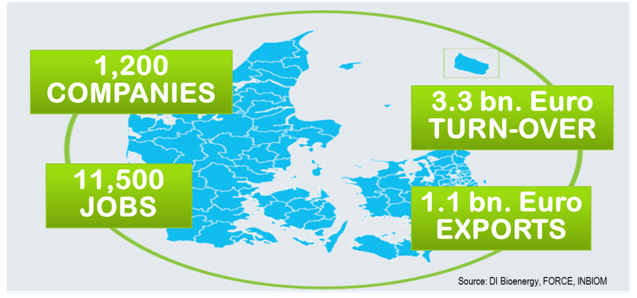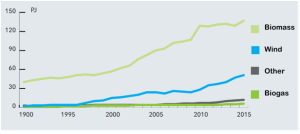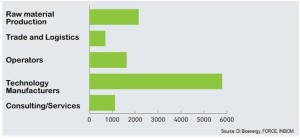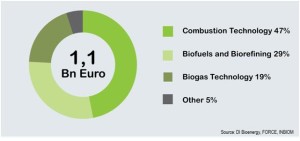Denmark is widely regarded as a pioneer in renewable energy, not least due to the highly developed wind energy industry. What few people know, however, is that bioenergy is by far the biggest contributor to renewable energy in Denmark.Moreover, Bioenergy also contributes substantially to the Danish economy in terms of jobs and exports. DI Bioenergy – Danish Bioenergy Association – carried out an analysis to bring numbers to the table in the discussion.
There is no doubt among people in the Danish bioenergy sectorthat bioenergy has many positive features. It has facilitateda fast transition away from coal, it provides flexibility to the energy system, and it solves a waste problem in agriculture. Moreover, it appears to be the only solution for heavy and air transport, and it is a stepping stone towards the bio-based society. However, not all stakeholders understand this.
Importance of the bioenergy cluster in Denmark
Lacking data it has been difficult to explain the importance of bioenergy in Denmark, in addition to the green transition. On this backgroundDI Bioenergy – Danish Bioenergy Association, together with FORCE Technology and INBIOMdecided to map the Danish bioenergy industry cluster and its importance for the Danish society. The result is clear, bioenergy brings about a considerable turnover, creates many jobs and exports, in addition to being an indispensable part of the energy transition.

The analysis reveals that the Danish bioenergy cluster encompasses more than 1,200 companies with a combined turn-over of 25 bn DKK (= 3.3 bn Euro). 11,500 jobs have been created covering feedstock production, logistics, energy production as well as production of equipment, engineering and services. The cluster has a total annual export of 8 bn DKK (= 1.1 bn Euro) in equipment, products and services.
The analysis reveals that the Danish bioenergy cluster encompasses more than 1,200 companies with a combined turn-over of 25 bn DKK (= 3.3 bn Euro). 11,500 jobs have been created covering feedstock production, logistics, energy production as well as production of equipment, engineering and services. The cluster has a total annual export of 8 bn DKK (= 1.1 bn Euro) in equipment, products and services.
The importance of bioenergy in the Danish energy system

In Denmark, renewable energy constitutes 23% of the Danish energy production and 28.6% of the Danish energy consumption, according to the Energy Agency’s Energy Statistics 2015. Bioenergy is by far the largest contributor of renewable energy, with 60% of the production and 69% of the consumption. The large share of bioenergy is mainly caused of conversion of CHP plants from formerly coal to now biomass, particularly imported wood pellets.
The Danish Energy Agency every year publishes a base scenario of the future Danish energy supply.It estimates that the largest transition into renewable energy towards 2020 will take place in the power and heat sector with continued conversions of CHP plants from coal into biomass and continued expansion of wind power. It is thus clear that bioenergy will continue to be the largest contributor to renewable energy for many years to come.
Method of the mapping of the Danish Bioenergy Cluster
Bioenergy encompasses all kinds of energy derived from biological material, whether from agriculture, forestryand livestock, as well as households and industry. Different technologies are used to convert the biomass into energy. In this analysisthe following technologies are included: Combustion (heat, combined heat and power and process, as well as incineration of the biological part of municipal solid waste), gasification (anaerobic digestion and thermal gasification), biorefining, including biofuels.
The value chain of bioenergy has been divided into the following steps: 1) raw material production, 2) collection, preparation and transportation of biomass, 3) energy production or conversion, 4) equipment manufacturers and suppliers, 5) consulting and services, in order to analyse the relative importance of the various steps in the value chain.
All companies operating within the above framework are included in the bioenergy cluster, but a conservative definition of the boundary of the cluster is used. For example, biomass produced as a residue at the farms are not included, as the residue is only a by-product of the main activity of the farm. The distribution of power and heat from biomass is not a part of the bioenergy cluster, as the power grid and district heat grid can carry power and heat from any type of technology. Likewise, biofuels blended into ordinary petrol and diesel are not included in the bioenergy cluster.
More than 1,200 companies were identified as belonging to the bioenergy cluster. The companies weredivided into 43 segments according to technology and step in the value chain. For each segment, data were drawn from the Statistical Bureau of Denmark and a bioenergy share was determined. 71 companies were too complex or there were too few companies in the segment to keep confidentiality. These companies were analysed individually and their data added back into the segments. Furthermore, the companies of some sectors were analysed in a sectorial approach, when it was deemed more accurate. The analysis covers the year 2014, which is the most recent year available from Statistical Bureau. Relevant industry associations were involved to ensure validity of the analysis, but the analysis and results is the responsibility of the three partners only.
Jobs in the bioenergy cluster

One of the most sought after data on the bioenergy cluster is its impact on jobs. The cluster brings about 11,500 jobs in total, including raw material producers, logistics, energy production, technology suppliers, consulting and services for the bioenergy industry. Technology suppliers are responsible for almost 6,000 of the jobs, while raw material production gives a bit more than 2,000 jobs and operators, i.e. energy companies, are responsible for approx. 1,800 jobs. Thus through their demand, the energy companies have helped to create a supplier industry with 3.5 times as many jobs.
Exports from the bioenergy cluster

The total export of equipment, additives and bioenergy products and services of the bioenergy cluster is about 1,1 bn Euro. Distributed on technology, combustion, including waste incineration, is 47%. Liquid biofuels and biorefining is about 29% and biogas technology is about 19%.
Impact of the analysis
The target group for the analysis is all stakeholders around the bioenergy industry. The intention was to emphasise the positive aspectsof bioenergy, particularly its positive impact on jobs and exports. With this knowledge, politicians, organisations, industry players obtain a more holistic picture of bioenergy. This can be very helpful when there are discussions of the future role of bioenergy in the future energy system. It is also beneficial when discussing priorities of public funding of research within energy.
The impact of the analysis has been very positive. The analysis has been reported in the press, especially the industry related press, but also in national media. Internationally there has also been much interest in the analysis and its methodology from other bioenergy associations. With such positive interest and feedback the partners are committed to follow up and expand the analysis in the future.
The full report is available in Danish and English on the website of DI Bioenergy:
http://energi.di.dk/dibioenergi/Pages/default.aspx
This post is based on an article by Michael Persson, Head of Secretariat, DI Bioenergy – Danish Bioenergy Association, published in BE-Sustainable Magazine, issue May 2017.


